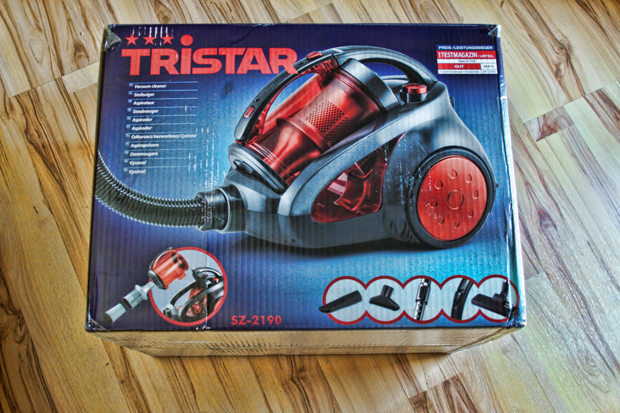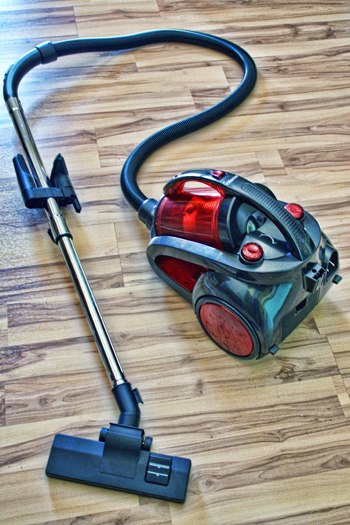Tristar Europe BV — 2200 Watt Bagless 220 Volt (German Market) Vacuum Cleaner — Review
© 2014 Peter Free
17 September 2014 (updated 16 October 2014 and 08 February 2015)


A decent, small and inexpensive vacuum cleaner
I came across the Tristar Europe B.V. 2200 watt (220 volt) bagless vacuum cleaner in Germany, while in need of a vacuum with which to clean hard floors.
At $99, at a US Air Force Base Exchange, this Dutch designed gizmo works well, but is messy to dump.
Background
My first two months into a Germany PCS (permanent change of station) persuaded me to avoid German products to the extent that I could.
In addition to producing overly complex and sometimes absurdly inefficient engineering solutions to simple problems, my sample of Deutschland’s manufacturers seemed to delight in producing instruction manuals written only in German.
When I spotted a Netherlands designed vacuum cleaner, contained in a manufacturer’s box labeled in 11 languages, I jumped on it.
Test conditions
The two story house we rent has tile and linoleum laminate floors. Its windows, as is the German practice, have no screens. Nor is there air conditioning.
Consequently, dust and dead bugs build up so quickly that one has to vacuum at least four times a week and preferably daily in the summer and twice a week in winter.
The Tristar 2200 watt bagless vacuum makes relatively easy work of this housekeeping.
It rolls without problems, having two large wheels on the back and a small swiveling one on the front. That said, I usually carry the unit via its clever handle. The handle allows two hand positions. One carries the lightweight unit horizontally and the other vertically.
This easy carry feature is especially useful on our tiled stairway, which would make for a nasty fall. The flight of stairs has a window at the bottom, conveniently positioned to rocket one out into the street amid a shower of glass. The Tristar’s light weight and convenient carrying ability makes short, safe work of the stairway.
The vacuum’s Dutch design is simple and clever
The Tristar has an automatically retracting cord, which makes it quick to store. Just push a large button on the unit’s body and in goes the cord.
Suction is adjustable via a similarly sized twist dial on the other side of the cleaner’s body. The maximum setting is strong enough that it takes a bit of effort to pull the upholstery fitting, for example, off the tile floor.
The crevice tool and the upholstery head both fit reasonably well on two tube-width plastic prongs attached to the upper portion of the aluminum suction tube. They don’t fall off, unless I fail to push them onto the prongs properly.
The third included tool is the floor head. It has no rotating brush, which would present a problem for people with lots of carpet, but it serves our hard floor purposes. Our experience has been that a rotating brush leaves marks on wood laminate floors and just pushes the dust around on tile.
The Tristar’s aluminum suction tube comes in one retractable piece, unlike more conventional designs that require one to carry around at least one loose tube. The retractable tube is attached to a conventional length of ridged, flexible plastic tubing.
The lower end of the Tristar’s aluminum tube slides into the upper to make the combined length variably shorter. This works by sliding a black plastic release on the upper tube and pushing the notched lower tube into it. The notches on the lower tube keep the selected intermediate position securely in place.
The vacuum is easy, but messy to empty. A push button (located toward the rear wheels) releases the dust canister. A second button (located near the front of the vacuum) on the same container releases the lid. There is no bag. The vacuum empties like a Dyson. Which means that sometimes there will be a mess to clean up, as stray bits miss the trash can.
Instruction manual
The English section is clearly and unmistakably written. So too, I think, is the French.
I assume that the other 9 languages are, as well.
Three noticeable negatives
The Tristar vacuum’s cord is shorter than Americans are accustomed to. It is not long enough to clean a large room from just one electrical outlet. One has to plug and unplug it a couple of times for bigger spaces. On the stairway, I either have to plug and unplug it or add a short extension cord. This compromise is probably due to the decision to make the cord retractable.
Second, the vacuum hose is cheap plastic that sometimes undoes itself from the motor housing. One has to twist it back into place by screwing the circular ridges on the hose back into the receptacle. This is not a big deal, but it is an indication of cost cutting.
The third flaw is the HEPA filter design. Like Dyson, the Tristar uses a detachable plastic container for dust. Like Dirt Devil and unlike Dyson, this dust canister includes a replaceable paper cone filter that quickly gets coated with dust and fluff. I use a stiff brush to clean it. The cleaning process makes a mess. Even outside, fine dust from the filter winds up on one’s clothes. Dyson’s more durable, flat and washable filter reduces the sprinkling dust problem.
The moral? — A decent inexpensive vacuum for hard floors, but with a couple of annoyances
At $99, this reasonably well performing Tristar vacuum cleaner is a bargain. Were I to do it again, however, I would probably look for a vacuum cleaner that uses a disposable bag or has a Dyson-like washable filter instead of a messy paper cone.
 PeteFree.com
PeteFree.com